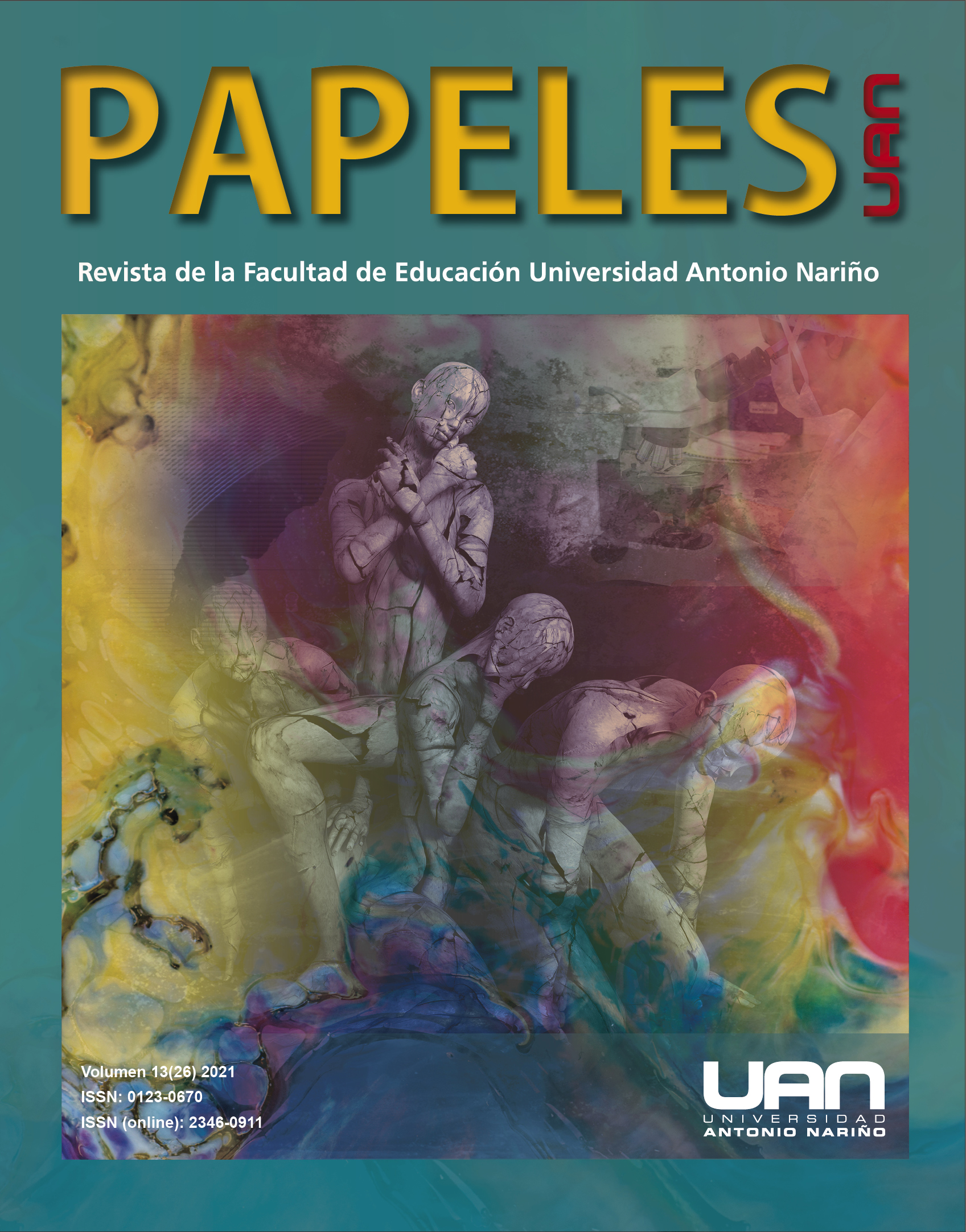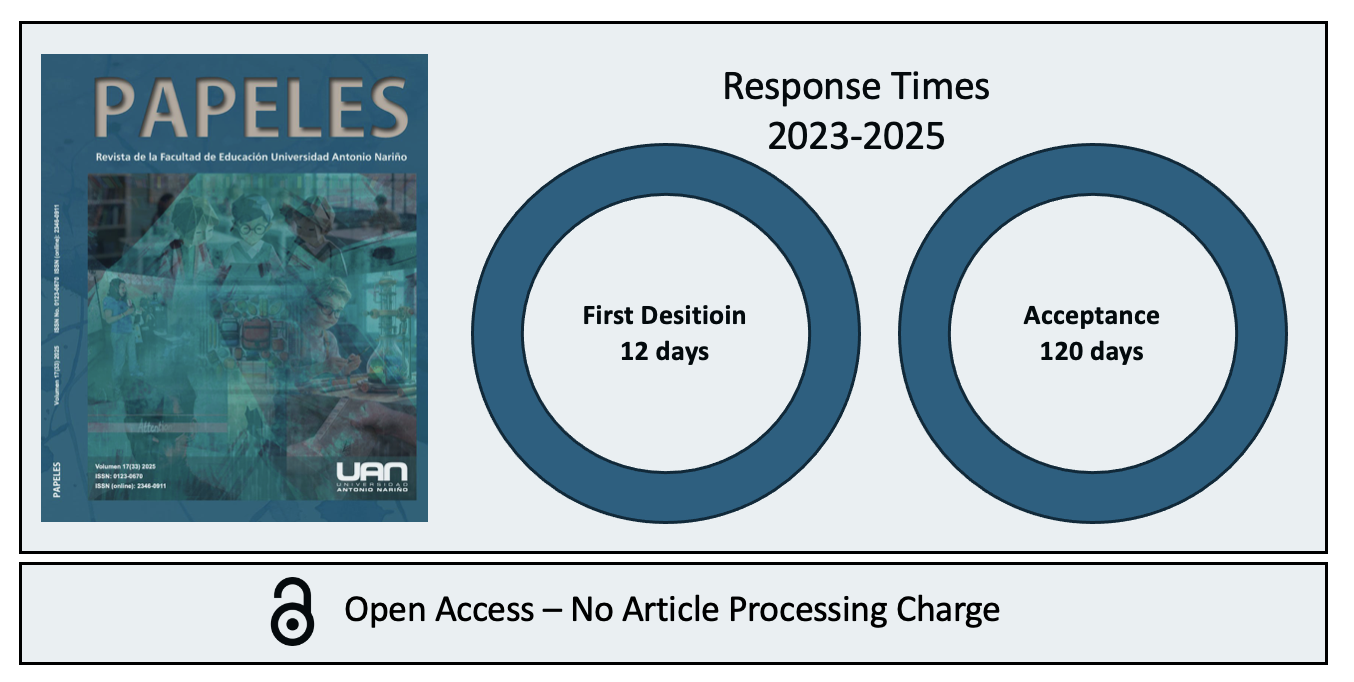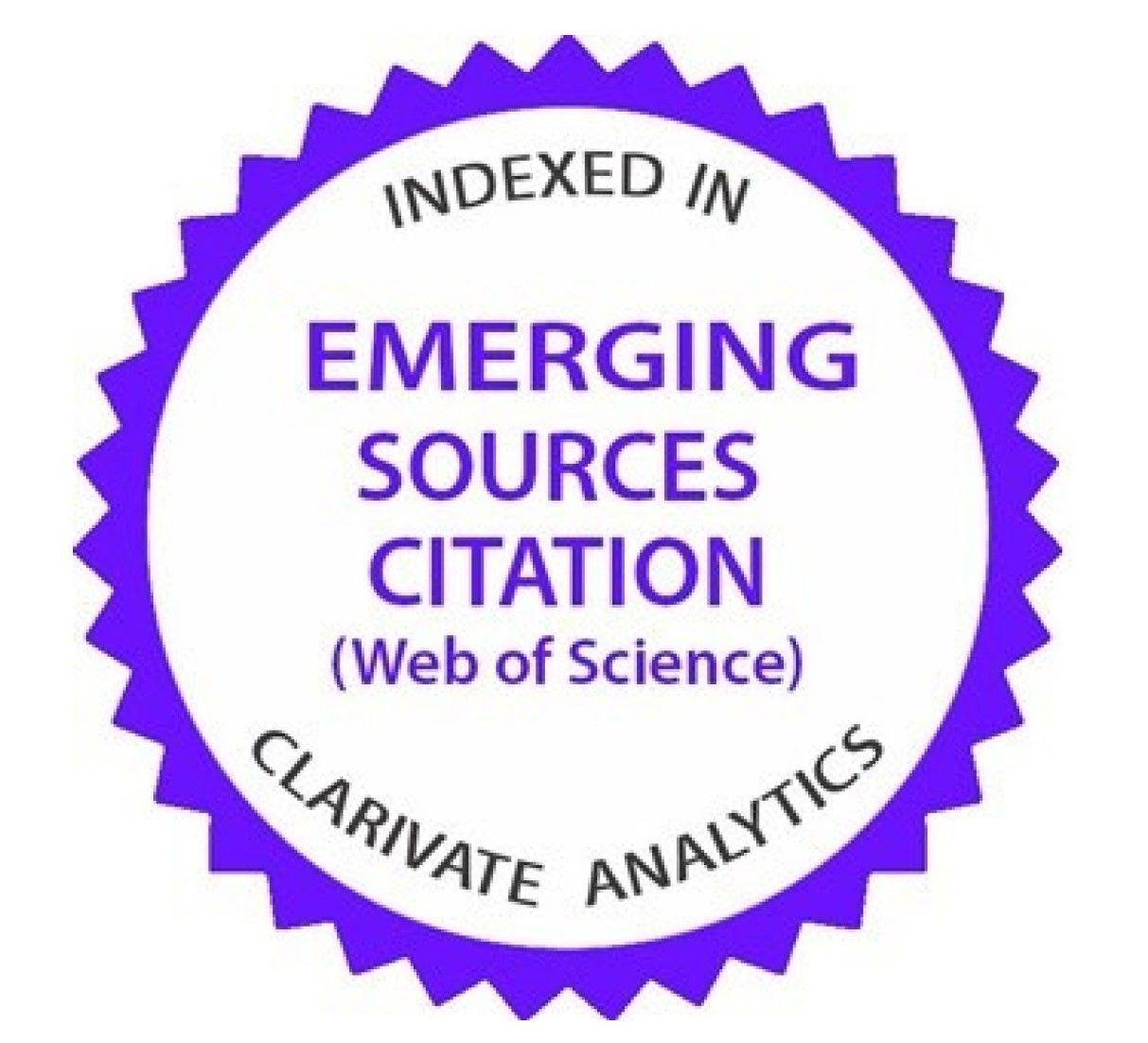The flood risk in the current context of climate change. Didactic proposals to teach in the school Geography
El riesgo de inundación en el contexto actual de cambio climático. Propuestas didácticas para su enseñanza en la Geografía escolar
DOI:
https://doi.org/10.54104/papeles.v13n26.1122Keywords:
flood, climate change, didactics, Mediterranean, education, geographyAbstract
In Spain, the importance of teaching atmospheric risks has reached the political sphere with the intention of improving how these contents are treated in non-university stages. This interest is determined by the fact that education is an action of vital necessity to increase the adaptation and resilience of natural risks in the current context of climate change, as reflected in the 2030 Agenda (United Nations Organization). The objective of this work is to propose didactic activities (Spanish context) in the subject of Geography (Secondary Education and Baccalaureate) on the risk of flooding, one of the main effects associated with the climate warming process in the Mediterranean region. With its implementation it is intended, on the one hand, to eliminate the deficiencies evidenced in the training of students in relation to the sources from which they obtain information, and on the other, to promote the importance that education has in the prevention and mitigation of risks climatic. This proposal has also been prepared with the intention of being a guide to be implemented in other regions with similar climatic and socio-economic characteristics.
Downloads
References
Agencia Estatal de Meteorología (2021). Mapa de la red básica de observación meteorológica en España. https://aemetblog.es/2016/11/28/la-observacion-en-aemet/
Adaptecca (2021). Visor de escenarios de Cambio climático. https://escenarios.adaptecca.es/#&model=EURO-CORDEX-EQM.average&variable=tasmax&scenario=rcp85&temporalFilter=year&layers=AREAS&period=MEDIUM_FUTURE&anomaly=RAW_VALUE
Arnell, N.W., Lowe, J.A., Challinor, A.J., & Osborn, T.J. (2019). Global and regional impacts of climate change at different levels of global temperature increase. Climatic Change, 155, 377-391. https://doi.org/10.1007/s10584-019-02464-z
Beck, U. (1993). De la sociedad industrial a la sociedad del riesgo. Revista de Occidente, 63, 18-40.
Bel, J.C., Colomer, J.C., & Valls, R. (2019). Alfabetización visual y desarrollo del pensamiento histórico: Actividades con imágenes en manuales escolares. Educación XX1, 22(1), 353-374. http://doi: 10.5944/educXX1.20008.
Bosschaart, A., van der Schee, J., & Kuiper, W. (2016). Designing a flood-risk education program in the Netherlands. Journal of Environmental Education, 47 (4), 271-286. https://doi.org/10.1080/00958964.2015.1130013
Brisman, A. (2018). Representing the “invisible crime” of climate change in an age of post-truth. Theoretical Criminology, 22(3), 468-491. https://doi.org/10.1177/1362480618787168
Burton, I.R., Kates, R., & White, G.F. (1978). The environment as hazard. Oxford University Press.
Calvo, F. (2001). Sociedades y territorios en riesgo. Ediciones del Serbal.
Centre for Research on the Epidemiology of Disasters (CRED) (2019). Economic Losses, Poverty & Disasters (1998-2017). https://www.emdat.be/.
Centros de Estudios y Experimentación de Obras Públicas (CEDEX) (2017). Evaluación del impacto del cambio climático en los recursos hídricos y sequías en España. Ministerio de Agricultura y Pesca, Alimentación y Medio Ambiente y Ministerio de Fomento.
Cuello, A. (2018). Las Inundaciones del invierno 2009-2010 en la prensa, un recurso educativo para las ciencias sociales. REIDICS: Revista de Investigación en Didáctica de las Ciencias Sociales, 2, 70-87.
De Luis, M., Brunetti, M., Gonzalez-Hidalgo, J.C., Longares, L. A., & Martín-Vide, J. (2010). Changes in seasonal precipitation in the Iberian Peninsula during 1946–2005. Global and Planetary Change, 74 (1), 27-33. https://doi.org/10.1016/j.gloplacha.2010.06.006
Diario Información (04.09.2021). La digitalización educativa no puede con los libros de texto en papel. https://www.informacion.es/sociedad/2021/09/04/digitalizacion-educativa-libros-texto-papel-56933740.html
Díez-Herrero, A., Hernández-Ruiz, M., Díez-Marcelo, P., & Carrera, C. (2020). Programa de Educación Infantil en el riesgo de inundaciones ‘Venero Claro-Agua’ (Ávila). En I. López Ortiz, J. Melgarejo & P. Fernández (Coords.), Riesgo de inundación en España: análisis y soluciones para la generación de territorios resilientes (pp. 1191-1200). Universidad de Alicante.
Díez-Herrero, A., Hernández-Ruiz, M., Daniel Vázquez, D., & Velasco, M. (2021). Incorporación de contenidos sobre el riesgo de inundación en la educación vial. En J. Melgarejo, M.I. López & Fernández, P. (Eds), Inundaciones y sequías. Análisis multidisciplinar para mitigar el impacto de los fenómenos climáticos extremos (pp. 225-236). Universitat d’Alacant.
EM-DAT (2021). EM-DAT Query Tool. The International Disasters Database. Centre for Research on the Epidemiology of Disasters (CRED). https://public.emdat.be/data
Ferrari, E., Anne-Marie Ballegeer, A. M., Fuertes, M. A, Herrero, P., Delgado, L., Corrochano, D., Andrés-Sánchez, S., Bisquert, K. M., Garcia-Vinuesa, A., Meira, P., Martinez, F., & Ruiz, C. (2019). Improvement on Social Representation of Climate Change through a Knowledge-Based MOOC in Spanish. Sustainability, 11, 1-21. https://doi.org/10.3390/su11226317
García-Francisco, J., Pardo, P., & Rebollo, L.F. (2009). La desertificación y otros problemas ambientales en los libros de texto de geografía de educación secundaria en España. En F. Pillet, M.C. Cañizares & A. Ruiz (Coords.), Geografía, territorio y paisaje. El estado de la cuestión: actas del XXI Congreso de Geógrafos Españoles (pp. 1.757-1.772). Asociación de Geógrafos Españoles.
García-Martín, J.A., Amérigo. M.J., Bodoque, J.M., Díez-Herrero, A., Raquel Pérez-López, R., & Talayero, F. (2020). Análisis de la percepción social para la gestión y comunicación del riesgo de inundaciones. En I. López Ortiz, J. Melgarejo & P. Fernández (Coords.), Riesgo de inundación en España: análisis y soluciones para la generación de territorios resilientes (pp. 1069-1086). Universidad de Alicante.
Generalitat Valenciana (2020). Plan Vega Rehace. Una estrategia integral para la resiliencia de la comarca de la Vega Baja del Segura. Valencia, Dirección General de Análisis y Políticas Públicas. http://www.presidencia.gva.es/es/web/vega-renhace
Gil-Guirado, S., Pérez-Morales, A., Pino, D., Peña, J.C., & López-Martínez, F. (2021). Flood impact on the Spanish Mediterranean coast since 1960 based on the prevailing synoptic patterns. Science of The Total Environment. https://doi.org/10.1016/j.scitotenv.2021.150777
González, J. C., López, J.A., Stepanek, P., Martín-Vide, J., & De Luis, M. (2009). Monthly precipitation trends on the Mediterranean façade of the Iberian Peninsula during the second half of the 20th century (1951-2000). International Journal of Climatology, (29), 1.415-1.429. https://doi.org/10.1002/joc.1780
Hernández-Ruiz, M., Miguel García-Pozuelo, M., Díez-Herrero, A., & Carrera, C. (2020). Mejora de la percepción y conocimiento infantil sobre el riesgo de inundaciones: Programa ‘Venero Claro-Agua’ (Ávila). En I. López Ortiz, J. Melgarejo & P. Fernández (Coords.), Riesgo de inundación en España: análisis y soluciones para la generación de territorios resilientes (pp. 1201-1210). Universidad de Alicante.
Instituto Cartográfico Valenciano (2021). Plan de Acción Territorial de carácter sectorial sobre prevención del Riesgo de Inundación en la Comunidad Valenciana (PATRICOVA). https://visor.gva.es/visor/
Instituto Nacional de Estadística (INE) (2021). Demografía y población. https://www.ine.es/
Intergovernmental Panel on Climate Change (IPCC) (2014). Climate Change 2013 and Climate Change 2014 (3 vols.). http://www.ipcc.ch/
Intergovernmental Panel on Climate Change (IPCC) (2021). Climate Change 2021: The Physical Science Basis. Contribution of Working Group I to the Sixth Assessment Report of the Intergovernmental Panel on Climate Change [Masson-Delmotte, V., P. Zhai, A. Pirani, S. L. Connors, C. Péan, S. Berger, N. Caud, Y. Chen, L. Goldfarb, M. I. Gomis, M. Huang, K. Leitzell, E. Lonnoy, J. B. R. Matthews, T. K. Maycock, T. Waterfield, O. Yelekçi, R. Yu and B. Zhou (eds.)]. Cambridge University Press. In Press.
Jacobi, P.R. (2005). Impactos socio-ambientales urbanos del riesgo de la búsqueda de la sustentabilidad: el caso de la Región Metropolitana de São Paulo. Ciudad y territorio: Estudios territoriales, 145-146, 671-682.
Kažys, J. (2018). Climate change information on internet by different Baltic Sea Region languages: Risks of disinformation & misinterpretation. Journal of Security and Sustainability Issues, 7 (4), 685-695. https://doi.org/10.9770/jssi.2018.7.4(6)
Kurup, P.M., Levinson, R., & Li, X. (2021). Informed-Decision Regarding Global Warming and Climate Change Among High School Students in the United Kingdom. Canadian Journal of Science, Mathematics and Technology Education, 21, 166-185. https://doi.org/10.1007/s42330-020-00123-5
Lechowicz, M., & Nowacki, T. (2014). School education as an element of natural disaster risk reduction. Prace i Studia Geograficzne, (55), 85-95.
Lee, Y., Kothuis, B.B., Sebastian, A., & Brody, S. (2019). Design of transformative education and authentic learning projects: Experiences and lessons learned from an international multidisciplinary research and education program on flood risk reduction. ASEE Annual Conference and Exposition, Conference Proceedings.
Lozina, A.A., & Pagliaricci, F. (2015). La escuela desde el barrio. Extensión en red, 6, 28-35.
Martín-Vide, J. (2009). Diez verdades y diez mentiras en relación al cambio climático. Enseñanza de las Ciencias de la Tierra, 17 (2), 120-127.
Masters, M. (2020). 123 curiosidades que todo el mundo debería conocer sobre el clima. Geoplaneta.
Ministerio del Interior (2020). Anuario Estadístico, 2019. Secretaría General Técnica. Madrid. http://www.interior.gob.es/documents/642317/1204854/Anuario+Estad%C3%ADstico+del+Ministerio+del+Interior+2019/81537fe0-6aef-437a-8aac-81f1bf83af1a
Ministerio de Educación, Cultura y Deporte (2021). Real Decreto 1105/2014 de 26 de diciembre, por el que se establece el currículo básico de la Educación Secundaria Obligatoria y del Bachillerato. https://boe.es/buscar/pdf/2015/BOE-A-2015-37-consolidado.pdf
Ministerio para la Transición Ecológica y el Reto Demográfico (2021). Sistema Nacional de Cartografía de Zonas Inundables (SNCZI). https://sig.mapama.gob.es/snczi/index.html?herramienta=DPHZI
Miró, J., & Olcina, J. (2020). Cambio climático y confort térmico. Efectos en el turismo de la Comunidad Valenciana. Investigaciones Turísticas, 20, 1-30. https://doi.org/10.14198/ INTURI2020.20.01
Monjo, R., & Martín-Vide, J. (2016). Daily precipitation concentration around the world according to several indices. International Journal of Climatology, 36 (11), 3.828-3.838. https://doi.org/10.1002/joc.4596
Morán, E., Herrera, S., López, J.I., Revuelto, J., & Beniston, M. (2012). Evolución reciente de las condiciones de humedad y temperatura en las montañas españolas y su relación con la cubierta nivosa. En Asociación Española de Climatología. VIII Congreso Internacional Asociación Española de Climatología: Cambio climático (pp. 891-898). Asociación Española de Climatología.
Morote, A.F. (2017). El Parque Inundable La Marjal de Alicante (España) como propuesta didáctica para la interpretación de los espacios de riesgo de inundación. Didáctica Geográfica, 18, 211-230.
Morote, A.F., & Pérez-Morales, A. (2019). La comprensión del riesgo de inundación a través del trabajo de campo: Una experiencia didáctica en San Vicente del Raspeig (Alicante). Vegueta. Anuario de la Facultad de Geografía e Historia, 19, 609-631.
Morote, A.F., & Hernández, M. (2020). Social Representations of Flooding of Future Teachers of Primary Education (Social Sciences): A Geographical Approach in the Spanish Mediterranean Region. Sustainability, 12 (15), 1-14. https://doi.org/10.3390/su12156065
Morote, A. F., & Moreno, J.R. (2021). La percepción de los futuros docentes de Educación Secundaria sobre las implicaciones territoriales del cambio climático en destinos turísticos del litoral mediterráneo. Grand Tour. Revista de Investigaciones Turísticas, 23, 261-282.
Morote, A.F., & Olcina, J. (2020). El estudio del cambio climático en la Educación Primaria: una exploración a partir de los manuales escolares de Ciencias Sociales de la Comunidad Valenciana. Cuadernos Geográficos, 59 (3), 158-177. http://dx.doi.org/10.30827/cuadgeo.v59i3.11792
Morote, A. F., & Olcina, J. (2021a). Cambio climático y sostenibilidad en la Educación Primaria. Problemática y soluciones que proponen los manuales escolares de Ciencias Sociales. Sostenibilidad: económica, social y ambiental, 3, 25-43. https://doi.org/10.14198/Sostenibilidad2021.3.02
Morote, A.F., & Souto, X.M. (2020). Educar para convivir con el riesgo de inundación. Estudios Geográficos, 81 (288), e036. https://doi.org/10.3989/estgeogr.202051.031.
Morote, A.F., Campo, B., & Colomer, J.C. (2021a). Percepción del cambio climático en alumnado de 4º del Grado en Educación Primaria (Universidad de Valencia, España) a partir de la información de los medios de comunicación. Revista Electrónica Interuniversitaria de Formación del Profesorado, 24(1), 131-144. DOI: https://doi.org/10.6018/reifop.393631
Morote, A. F., Hernández, M., & Olcina, J. (2021b). Are Future School Teachers Qualified to Teach Flood Risk? An Approach from the Geography Discipline in the Context of Climate Change. Sustainability, 13 (15), 8560, 1-22. https://doi.org/10.3390/su13158560
Muñoz, C., Schultz, D., & Vaughan, G. (2020). A Midlatitude Climatology and Interannual Variability of 200- and 500-hPa Cut-Off Lows. Journal of Climate, 33 (6), 2.201-2.222.
Nelles, D., & Serrer, C. (2020). El pequeño manual del cambio climático. Grijalbo.
Olcina, J. (2017). La enseñanza del tiempo atmosférico y del clima en los niveles educativos no universitarios. Propuestas didácticas. En R. Sebastiá & E. M. Tonda (Eds.), Enseñanza y aprendizaje de la Geografía para el siglo XXI (pp. 119-148). Universidad de Alicante.
Olcina, J. (2018). Verdades y mentiras sobre el riesgo de inundaciones en el litoral mediterráneo: balance de medio siglo. Jornada sobre fenómenos meteorológicos extremos en el mediterráneo. 11 de diciembre de 2018. Valencia, AEMET.
Olcina, J. (2020). Clima, cambio climático y riesgos climáticos en el litoral mediterráneo español. Oportunidades para la geografía. Documents d´Analisis Geografica, 66 (1), 159-182. https://doi.org/10.5565/rev/dag.629
Olcina, J., & Biener, S. (2019). ¿Está cambiando el clima valenciano?. Realidades e incertidumbres. En J. Olcina & E.A. Moltó (Eds.), Climas y Tiempos en el País Valencià (pp. 162-170). Publicaciones de la Universidad de Alicante.
Organización de las Naciones Unidas (2015). Sustainable Development Goals. UNDP, Sustainable Development Agenda. https://www.undp.org/content/undp/es/home/sustainable-development-goals/resources.html
Pastor, F., Valiente, J.A., & Khodayar, S. (2020). A Warming Mediterranean: 38 Years of Increasing Sea Surface Temperature. Remote Sensing, 12 (17), 2687. https://doi.org/10.3390/rs12172687
Pausas, J.G., & Millán, M.M. (2019). Greening and browning in a climate change hotspot: the Mediterranean Basin. BioScience, 67 (2), 143-151. https://doi: 10.1093/biosci/biy157
Pérez-Morales, A., Gil, S., & Quesada, A. (2021). Do we all stand equally towards the flood? Analysis of social vulnerability in the Spanish Mediterranean coast. Boletín de la Asociación de Geógrafos Españoles, 88, 1-39. https://doi.org/10.21138/bage.2970
Revista Mercados (2021). DANA 2019. www.revistamercados.com
Roussel, D., & Cutter-Mackenzie-Knowles, A. (2020). A systematic review of climate change education: giving children and Young people a voice and a hand in redressing climate change. Children’s Geography, 18(2), 191-208. https://doi.org/10.1080/14733285.2019.1614532
Sailme (2021). Fotografía de Calpe. https://sailme.eu/wp-content/uploads/2015/09/calp1.jpg
Serrano, R. (2017). Reconstrucción climática instrumental de la precipitación diaria en España: ensayo metodológico y aplicaciones (Tesis doctoral). Universidad de Zaragoza. Zaragoza.
Shah, A. A., Gong, Z., Ali, M., Sun, R., Naqvi, S. A. A., & Arif, M. (2020). Looking through the Lens of schools: Children perception, knowledge, and preparedness of flood disaster risk management in Pakistan. International Journal of Disaster Risk Reduction, 50, 101907. https://doi.org/10.1016/j.ijdrr.2020.101907
Tamayo, J., & Núñez, J.A. (2020). Precipitaciones intensas en la Comunidad Valenciana: Análisis, sistemas de predicción y perspectivas ante el cambio climático. En I. López Ortiz, J. Melgarejo & P. Fernández (Coords.), Riesgo de inundación en España: análisis y soluciones para la generación de territorios resilientes (pp. 49-62). Universitat d’Alacant.
Tsai, M.H., Chang, Y.L., Shiau, J.S., & Wang, S.M. (2020). Exploring the effects of a serious game-based learning package for disaster prevention education: The case of Battle of Flooding Protection. International Journal of Disaster Risk Reduction, 43, 101393. https://doi.org/10.1016/j.ijdrr.2019.101393
Valdanha, D., & Jacobi, P.R. (2021). Etnoconservación y educación ambiental en Brasil: resistencias y aprendizaje en una comunidad tradicional. Praxis & Saber, 12 (28), 11443.
Wetterzentrale (2021). Archivo, CFSR (1979-). https://www.wetterzentrale.de/
White, G.F. (1974). Natural Hazards. Local, Regional and Global. Oxford University Press.
Williams, S., McEwen, L. J., & Quinn, N. (2017). As the climate changes: Intergenerational action-based learning in relation to flood education. The Journal of Environmental Education, 48 (3), 154-171.
Zhong, S., Cheng, Q., Zhang, S., Huang, C., & Wang, Z. (2021). An impact assessment of disaster education on children’s flood risk perceptions in China: Policy implications for adaptation to climate extremes. Science of the total environment, 757, 143761. https://doi.org/10.1016/j.scitotenv.2020.143761
Downloads
Published
-
Abstract702
-
PDF (Español)393
How to Cite
Issue
Section
Categories
License
Copyright (c) 2021 Álvaro-Francisco Morote, Jorge Olcina Cantos

This work is licensed under a Creative Commons Attribution-NonCommercial-ShareAlike 4.0 International License.






